Top speed 1,041 km/h Length 12 m Manufacturer Grumman | Wingspan 11 m First flight September 20, 1951 Number of seats 2 | |
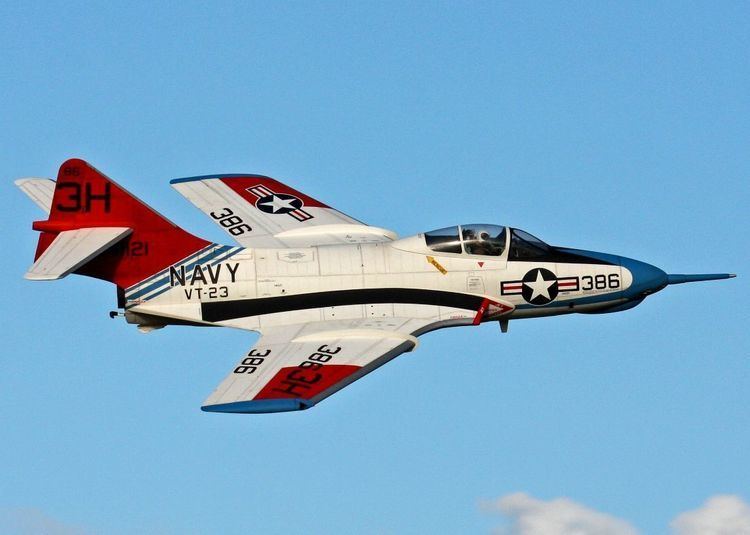 | ||
Engine types Turbojet, Pratt & Whitney J48 | ||
Grumman f 9 cougar turbine at best in the west 2015
The Grumman F9F/F-9 Cougar was an aircraft carrier-based fighter aircraft for the United States Navy and United States Marine Corps. Based on Grumman's earlier F9F Panther, the Cougar replaced the Panther's straight wing with a more modern swept wing. Thrust was also increased. The Navy considered the Cougar an updated version of the Panther, despite having a different official name, and thus Cougars started off from F9F-6 upward.
Contents
- Grumman f 9 cougar turbine at best in the west 2015
- Early Development
- F9F 6
- F9F 7
- Flexible deck testing
- F9F 8
- Aerial reconnaissance
- Flight characteristics and expert opinions
- United States
- Transcontinental speed record
- Blue Angels
- Argentina
- Variants
- Operators
- Specifications F9F 6F 9F
- References
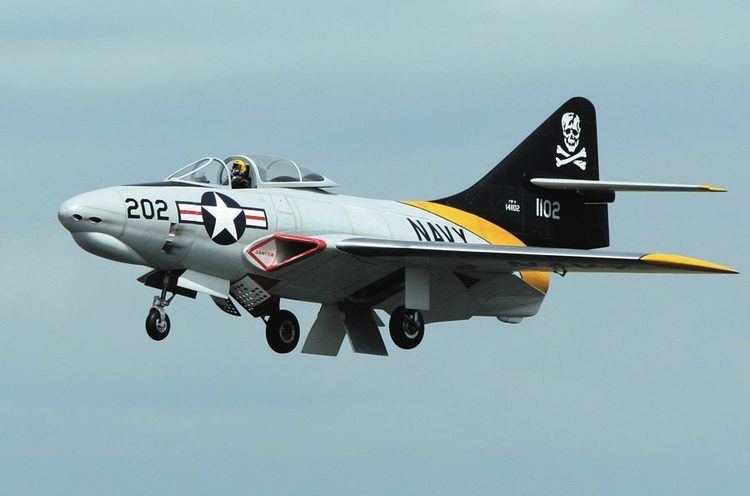
Early Development
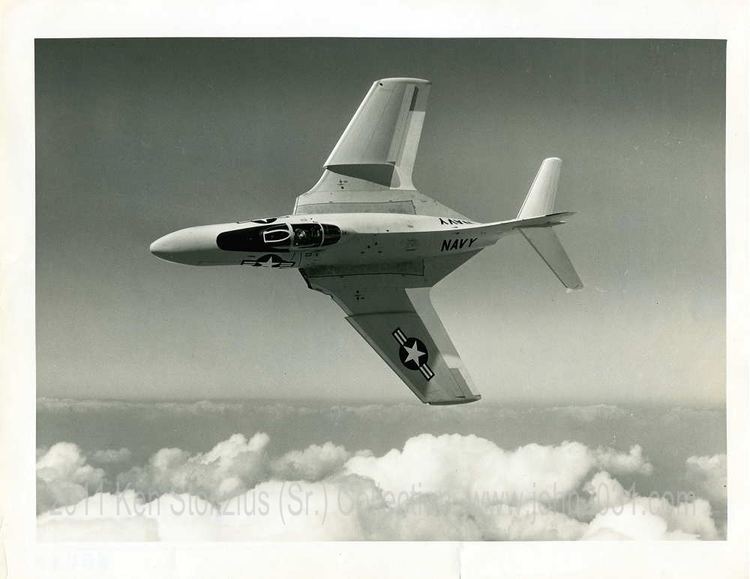
Rumors that the Soviet Union had produced a swept-wing fighter had been circulating since 1948 and the Mikoyan-Gurevich MiG-15 was widely shown at air shows in 1949. Despite the level of activity taking place with swept-wing aircraft, the Navy was initially not heavily focused on the development of such aircraft. This was largely because the Navy's focus at the time was defending the battle group against high speed and high altitude bombers with interceptors, as well as escorting medium-range carrier-based bombers in all types of weather conditions. Nonetheless the Navy appreciated the importance of getting a capable carrier-based swept-wing jet fighter. Grumman was awarded a contract for the development of a swept-wing fighter jet in 1951. The arrival of the Mig 15, which easily outclassed straight-wing fighters in the air war over North Korea was a major contributing factor.
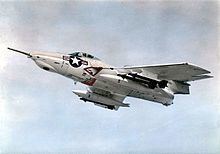
Prototypes were quickly produced by modifying Panthers, and the first (XF9F-6) flew on 20 September 1951. The aircraft was still subsonic, but the critical Mach number was increased from 0.79 to 0.86 at sea level and to 0.895 at 35,000 ft (10,000 m), improving performance markedly over the Panther. Instead of using conventional ailerons for roll control; the F9F-6 uses spoilers on the upper surfaces of the wing. Wing fences were soon added and the spoilers extended from the fences to the tips of the wing. The rudder pedals controlled the part of the rudder below the horizontal tail surface, while the upper portion of the rudder was controlled by a yaw damper. This allowed the Cougar to fly safely and easily without the upper portion of the tail. The Cougar was too late for Korean War service, however, and thus combat effectiveness estimates of the Cougar against potential foes such as the (likewise subsonic, but not carrier-rated) Soviet MiG-15 necessarily remain in the sphere of conjecture.
F9F-6

Initial production (646 airframes) was the F9F-6, delivered from mid-1952 through July 1954. The F9F-6 first flew on September 20, 1951, seven months after Grumman signed a contract with the Navy for swept-wing fighter. The first 30 production aircraft used the same J42 P-6 engine used in the F9F-5, but was then replaced by the more powerful J42 P-8 with 7,250 pounds of thrust. Armament was four 20 mm (.79 in) It had AN/M3 cannons in the nose and provisions for two 1,000 lb (450 kg) bombs or 150 US gal (570 l) drop tanks under the wings. Most were fitted with a UHF homing antenna under the nose, and some were fitted with probes for inflight refuelling. The F9F-6 used an Aero 5D-1 weapons sight with an APG-30A gun-ranging radar. The F9F-6 was later designated F-9F in 1962. Sixty were built as F9F-6P reconnaissance aircraft with cameras instead of the nose cannon. The F9F/F-9 Cougar is one of few aircraft which do not have ailerons; it uses spoilers for roll control. After withdrawal from active service, many F9F-6s were used as unmanned drones for combat training, designated F9F-6D, or as drone controllers, designated F9F-6K. The F9F-6K and the F9F-6D were redesignated the QF-9F and DF-9F, respectively.
F9F-7
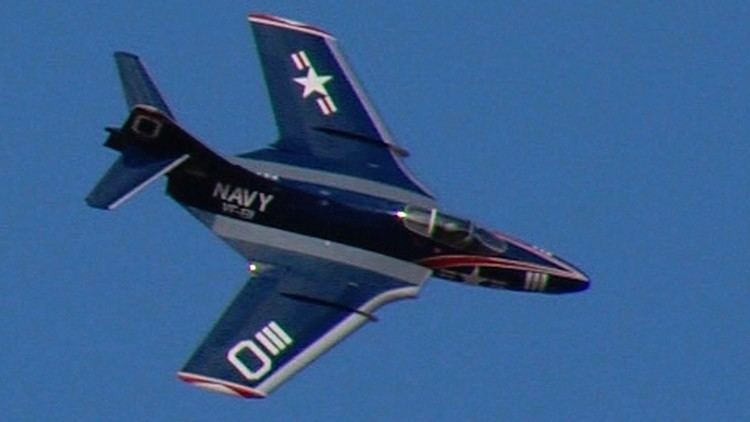
The F9F-7 referred to the next batch of Cougars that were given the Allison J33 also found in the F9F-4, instead of the Pratt & Whitney J48. A total of 168 were built, but the J33 proved both less powerful and less reliable than the J48. Almost all were converted back to the J48 engine, and were thus indistinguishable from F9F-6s. These were redesignated F-9H in 1962.
Flexible deck testing
The Navy used two modified F9F-7s to conduct experiments landing on British-inspired flexible decks which did not require the use of landing gear. The reasoning was that since an airplane's landing gear comprises some 33% of the total weight, a plane without landing gear would gain a greater range and would be able to carry more ordnance. The aircraft were fitted with a 3-inch-deep false bottom under the center fuselage to help balance the plane during landings on the flex-deck made up of a lubricated rubberized fabric. The deck, built by Goodyear was 1/2 inch thick and featured several arresting cables. The planes were launched using a ramp and a handling dolly which served as temporary landing gear. The two F9F-7 aircraft in the test were equipped with the powerful J48-P8 engine instead of the Allison J33 engine originally used with the F9F-7. While the landing tests yielded positive results and proved that landing was clearly possible, the project was terminated in 1955 as it would have been difficult to move the aircraft around the carrier deck once they landed. It also required a highly skilled pilot to perform the landings and would have made it impossible to divert to a land base if necessary.
F9F-8
Work on the F9F-8 began in April, 1953 with three goals: lower the airplane's stall speed, improve aircraft control at high angles of attack, and increase range. It featured an 8 in (20 cm) stretch in the fuselage and modified wings with a greater chord, an increased area (from 300 to 337 square feet) and a dogtooth. The airframe changes improved low-speed, high angle of attack flying and gave more room for fuel tanks. The top speed was 704 mph and minimum catapult speed was lowered to 127 knots (146 mph). It also was now capable of breaking the sound barrier in a steep dive. All four ammunition boxes were mounted above the guns, in contrast to the split location of most previous F9Fs including the Panther. Visibility, which was already very good was improved with the F9F-8. 601 aircraft were delivered between April 1954 and March 1957. Late production F9F-8 aircraft were given the ability to carry four AIM-9 Sidewinder air-to-air missiles under the wings (the first Navy aircraft to deploy with the missiles). Most earlier aircraft were later modified to carry Sidewinders. A number were given also nuclear bombing equipment. The F9F-9 was redesignated F-9J in 1962. The F9F-8B aircraft were F9F-8s converted into single-seat attack-fighters, later redesignated AF-9J. The Navy acquired 377 two-seat F9F-8T trainers between 1956 and 1960. They were used for advanced training, weapons training and carrier training, and served until 1974. They were armed with twin 20 mm (.79 in) cannon and could carry a full bombs or missiles load. In the 1962 redesignation, these were called TF-9J.
Aerial reconnaissance
A total of 110 F9F-8Ps (photo-reconnaissance) were produced with an extensively modified nose carrying cameras. They were withdrawn after 1960 to reserve squadrons. In 1962, surviving F9F-6P and F9F-8P aircraft were re-designated RF-9F and RF-9J respectively.
Modifications of F9F-8 to convert to F9F-8P:
Flight characteristics and expert opinions
The F9F was known to be highly maneuverable and easy to fly. Corky Meyer who flew both the F9F Cougar and North American FJ-3 Fury noted that compared to the FJ-3 the Cougar had greater endurance, had a higher dive speed limit (Mach 1.2 vs Mach 1), and had a higher maneuvering limit of 7.5-g compared to 6-g for the FJ-3.
"[The] Combat Air patrol mission was for two hours on station at 150 nm from the carrier. This required 2+30 takeoff, cruise, and landing endurance plus reserves. The F9F-6 could perform a three-hour CAP mission on internal fuel. The FJ-2 and -3 with external tanks had less that 1+30 mission time and the FJ-4 just met the mission requirement."
The F9F Cougar was also a capable multi-role aircraft, although this fact may have been the reason why it was deployed less often than other aircraft which had more categorical fighter roles. In spite of engine problems that plagued the FJ-3, it was deployed for a longer period than the F9F Cougar. Author and aeronautical engineer Tommy Thomason states that this was more likely attributable to the fact the F9F had an attack role that was being superseded by new jets such as A4D-1 Skyhawk, rather than any deficiency as a fighter.
"The reason the FJ-3 was deployed a little longer and a little more often (19 times vs 16) in fighter squadrons than the F9F-8 probably wasn't because it was the better fighter. More likely it was because it has a minimal capability as an attack aircraft, whereas the F9F-8 was good for that too, including nuclear weapon delivery. In effect the F9F-8 was a jet attack placeholder along with the F7U-3M, while the pipeline was being filled with the FJ-4Bs and A4Ds. As a result, the FJ-3 was the designated day fighter by default on most deployments"
United States
The first F9F-6s were assigned to fleet squadron VF-32 at the end of 1952. The First F9F Cougar squadron to actually deploy was VF-24, assigned to the USS Yorktown in August 1953 but arrived too late to the Korean theater to participate in the air war.
F9F-8s were withdrawn from front-line service in 1958–59, replaced by F11F Tigers and F8U Crusaders. The Naval Reserves used them until the mid-1960s, but none of the single-seat versions were used in the Vietnam War.
The only version of the Cougar to see combat was the TF-9J trainer (known as F9F-8T until 1962) during the Vietnam War. Detachments of four Cougars served with US Marines Headquarters and Maintenance Squadron 11 (H&MS-11) at Da Nang and H&MS-13 at Chu Lai, where they were used for fast-Forward Air Control and the airborne command role, directing airstrikes against enemy positions in South Vietnam between 1966 and 1968.
The TF-9J two-seat trainer had a long service with the U.S. Navy. It served as the Navy's advanced flight trainer for more than two decades. The proposed Cougar modification (reengined with a J52 engine) was rejected, and the Navy selected the TA-4F Skyhawk. The last Cougar was phased out when VT-4 re-equipped in February 1974. A F9F-8T, BuNo 14276, is displayed at the National Museum of Naval Aviation, Pensacola.
Transcontinental speed record
Despite missing the Korean war, the Navy put the F9F Cougar to good use setting the transcontinental crossing record on April 1, 1954. Three pilots from fleet squadron VF-21 completed the 2,438-mile flight in under four hours with LCdr. F.X. Brady setting the quickest time of 3 hours 45 minutes and 30 seconds. This was the first time the distance had been covered in under four hours. The three F9F-6 aircraft refueled over Kansas from a North American AJ Savage, using an experimental refueling probe mounted on the nose.
Blue Angels
The U.S. Navy's flight demonstration team, the Blue Angels flew four different variants of F9Fs from the F9F-2 Panther to the F9F-8. The Blue Angels replaced their six F9F-5 Panthers with six F9F-6s in 1953. This was short lived however and the Navy subsequently took them for fleet use without actually using the planes in an air show. They F9F-6s were then replaced with overhauled F9F-5s until 1954 when the Blue Angels switched to the F9F-8. The Blue Angels used the F9F-8 until 1957 they were replaced by the Grumman Gumman F11F-1 Tiger, although one two-seat F9F-8T was retained for press and VIP flights.
Argentina
The only foreign air arm to use the F9F Cougar was the Argentine Naval Aviation, who also used the F9F Panther as well. Two F9F-8T trainers were acquired in 1962, and served until 1971. The Cougar was the first jet to break the sound barrier in Argentina. One aircraft (serial 3-A-151) is on display at the Naval Aviation Museum (MUAN) at Bahía Blanca, while the other was sold to an owner in United States.
Variants
Operators
Argentina
United States
Specifications (F9F-6/F-9F)
Data from Avialogs
General characteristics
Performance
Armament
